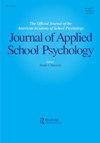The Importance of Growth in Oral Reading Fluency to Predict Performance on High-Stakes Assessments among Students Receiving Supplemental Intervention
IF 1.5
Q4 PSYCHOLOGY, EDUCATIONAL
引用次数: 4
Abstract
Abstract Educators and researchers measure student improvement in words read correct per minute (WRCM) to evaluate student response to reading interventions. The utility of evaluating improvement in WRCM via curriculum-based measures to make instructional decisions is based upon the assumption that growth in WRCM is predictive of performance on meaningful distal outcomes (e.g., state achievement tests). This study explored the relative value of measuring growth in WRCM to predict performance on an end of year state achievement test after controlling for baseline performance. We used quantile regression to analyze outcomes from 449 grade three students receiving tier II reading interventions to measure the relationship between growth in WRCM and performance on an end of year test across different levels of performance on that test. Results suggest that growth in WRCM is a meaningful predictor of performance on the end of year test after statistically controlling for baseline performance amongst students that perform better on that test (> 50th percentile). However, the amount of explained variance was consistently small (< 5%). Progress monitoring measures that more closely resemble the criterion of interest may be worth exploring for students that have made the transition from fluency to comprehension, while measures targeting lower order skills may be warranted for students with persistent fluency deficits.在接受补充干预的学生中,口语阅读流利度的增长对预测高风险评估表现的重要性
摘要教育工作者和研究人员测量学生在每分钟正确阅读单词(WRCM)方面的进步,以评估学生对阅读干预的反应。通过基于课程的措施来评估WRCM的改进以做出教学决策的效用是基于这样的假设,即WRCM的增长可以预测有意义的远端结果(例如,状态成就测试)的表现。本研究探讨了在控制基线表现后,测量WRCM的增长以预测年终状态成就测试表现的相对价值。我们使用分位数回归分析了449名接受二级阅读干预的三年级学生的结果,以衡量WRCM的增长与年终测试中不同表现水平的表现之间的关系。结果表明,WRCM的增长是年终考试成绩的一个有意义的预测因素,在统计上控制了在该考试中表现更好的学生的基线成绩(>50%)。然而,解释的方差一直很小(<5%)。对于已经从流利性过渡到理解的学生来说,更接近兴趣标准的进度监测措施可能值得探索,而针对低阶技能的措施可能对持续存在流利性缺陷的学生来说是有必要的。
本文章由计算机程序翻译,如有差异,请以英文原文为准。
求助全文
约1分钟内获得全文
求助全文
来源期刊

Journal of Applied School Psychology
PSYCHOLOGY, EDUCATIONAL-
CiteScore
2.40
自引率
10.00%
发文量
7
期刊介绍:
With a new publisher (Taylor & Francis) and a new editor (David L. Wodrich), the Journal of Applied School Psychology will continue to publish articles and periodic thematic issues in 2009. Each submission should rest on either solid theoretical or empirical support and provide information that can be used in applied school settings, related educational systems, or community locations in which practitioners work. Manuscripts appropriate for publication in the journal will reflect psychological applications that pertain to individual students, groups of students, teachers, parents, and administrators. The journal also seeks, over time, novel and creative ways in which to disseminate information about practically sound and empirically supported school psychology practice.
 求助内容:
求助内容: 应助结果提醒方式:
应助结果提醒方式:


